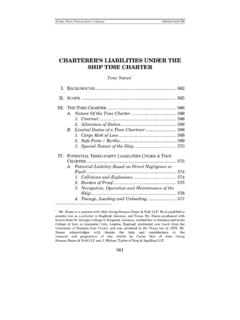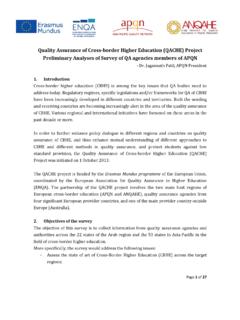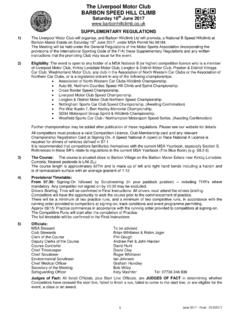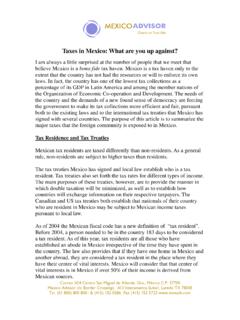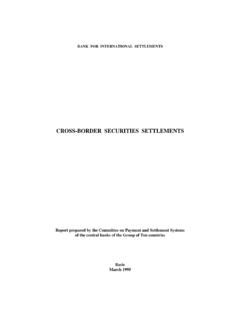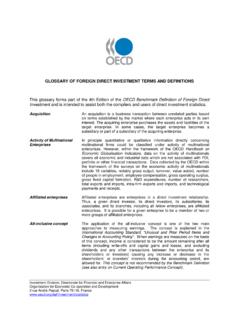Transcription of CROSS-BORDER UNITIZATION AND JOINT DEVELOPMENT …
1 UNITIZATION EIC EDITS 3/21/2007 9:17:41 AM 355 CROSS-BORDER UNITIZATION AND JOINT DEVELOPMENT AGREEMENTS: an international LAW PERSPECTIVE* Ana E. Bastida, Adaeze Ifesi-Okoye, Salim Mahmud, James Ross, and Thomas W lde** I. BASIC 360 A. Sources of international Law ..360 B. Sovereignty, Territory, and Boundaries ..362 II. DELIMITATION OF international MARITIME 364 A. Delimitation of the Continental Shelf ..364 B. Delimitation of the Exclusive Economic C. The Concept of CROSS-BORDER UNITIZATION ..370 D. The Concept of JOINT Petroleum DEVELOPMENT Agreements ..370 E. Rules Applicable to Develop Common III. IS THERE AN OBLIGATION TO COOPERATE UNDER CUSTOMARY international LAW? .. 375 A. international Case Law ..381 * This Article is a continuation of the Article titled Unitizing Oil and Gas Fields Around the World: A Comparative Analysis of National Laws and Private Contracts, published in Volume 28 of the Houston Journal of international Law.
2 See Jacqueline Lang Weaver and David F. Asmus, Unitizing Oil and Gas Fields Around the World: A Comparative Analysis of National Laws and Private Contracts, 28 HOUS. J. INT L L. 3 (2006). ** Professor Thomas W lde, Dr. Ana E. Bastida, Adaeze Ifesi-Okoye, and Salim Mahmud of Centre for Energy, Petroleum, and Mineral Law and Policy, University of Dundee, and Dr. James G. Ross of Ross Petroleum Limited. UNITIZATION EIC EDITS 3/21/2007 9:17:41 AM 356 HOUSTON JOURNAL OF international LAW [Vol. 29:2 1. The North Sea Continental Shelf 2. The Iceland/Norway Conciliation Recommendations on the Continental Shelf Area Between Iceland and Jan Mayen Island ..384 3. The 4. The Greece/Turkey Aegean Sea Continental Shelf 5. The Tunisia/Libya Continental Shelf Case ..388 6. The Australia/Indonesia Seabed 7.]
3 The Eritrea v. Yemen Tribunal Phase II Decision ..390 B. international Treaties and Agreements ..391 1. CROSS-BORDER UNITIZATION Agreements ..391 2. UNITIZATION a. Agreements in the North Sea ..391 i. Frigg agreement , 1976 ..393 ii. Statfjord agreement , 1979 ..395 iii. UNITIZATION of the Sunrise and Troubadour Fields, 2003 ..396 iv. Other Offshore CROSS-BORDER Unitizations ..398 b. Interlicensee UNITIZATION Agreements ..398 3. JOINT DEVELOPMENT Agreements ..399 a. Japan-South Korea agreement , b. Sudan-Saudi Arabia, 1974 ..401 c. Thailand-Malaysia, 1979/1990 ..402 d. Tunisia-Libya, 1988 ..404 e. Timor Gap Treaty (Australia-Indonesia), 1989 ..405 f. Guinea-Bissau-Senegal, 1993 g. JOINT Declaration, 1995 ..409 h. Timor Sea Treaty (Australia-East Timor), i. Nigeria-S o Tom e Pr ncipe, 2001 ..413 C. General Structure of Agreements ..414 1. Sharing of Resources ..415 2. Management ..415 UNITIZATION EIC EDITS 3/21/2007 9:17:41 AM 2007] CROSS-BORDER UNITIZATION 357 3.
4 Applicable Law ..417 4. Operator/Position of Contractors ..417 5. Financial 6. Dispute IV. SUMMARY AND 420 An understanding of the framework of the governing laws, regulations, model contracts, and existing agreements within the survey states as set forth in the earlier sections of this Article, as well as the practical advice in Section 5 of this Article, provides the international oil and gas practitioner with the necessary tools to negotiate a UNITIZATION agreement . However, when a reservoir straddles the boundary between two sovereign states, the complexities of any proposed UNITIZATION increases. Petroleum deposits often extend across national boundaries in such a manner that either portion can be exploited, wholly or in part, from the other side of the line. 1 Transboundary oil and gas deposits do not conform to property lines, licensing demarcations, or political boundaries.
5 2 The exploitation of those deposits in a JOINT , coordinated operation by respecting the common nature of petroleum reservoirs regardless of the boundaries they cross would seem to be the ideal strategy to undertake their DEVELOPMENT from a technical, conservationist, and environmental perspective. From a legal perspective, however, the DEVELOPMENT of common deposits straddling international boundaries raises complex and far-reaching issues. Under application of the fundamental principle that the territorial sovereignty or exclusive sovereign rights of states do not extend beyond their border , each state exercises exclusive authority over its own territory, and any infringement across an international boundary constitutes a 1. Rainer Lagoni, Oil and Gas Deposits Across National Frontiers, 73 AM. J. INT L LAW 215, 215 16 (1979). 2. Albert E.
6 Utton and Paul D. McHugh, On an Institutional Arrangement for Developing Oil and Gas in the Gulf of Mexico, 26 NAT. RESOURCES J. 717, 722 (1986). UNITIZATION EIC EDITS 3/21/2007 9:17:41 AM 358 HOUSTON JOURNAL OF international LAW [Vol. 29:2 violation of another state s territorial sovereignty or exclusive sovereign rights. 3 Since the DEVELOPMENT of deposits straddling international boundaries involves two or more sovereign states, it will be subject to different legal regimes and, consequently, different terms and conditions for exploration, exploitation, and transportation of oil and legal difficulties posed by the application of different statutes to a common reservoir can be overcome by the impacted states entering into a cooperative arrangement for its DEVELOPMENT .]
7 The principle of respect for the preservation of the unity of the deposit 5 as a means of resolving the problems of common petroleum deposits that straddle the boundary between states is reflected in the bilateral practice of entering into cooperative agreements. The absence of agreements to cooperate in the DEVELOPMENT of deposits straddling international boundaries raises thorny legal issues as there is no developed, crystalised [sic], or express rule or custom under international law requiring UNITIZATION for apportioning such common petroleum is important to draw a distinction between CROSS-BORDER UNITIZATION and JOINT petroleum DEVELOPMENT . Both CROSS-BORDER UNITIZATION and JOINT petroleum DEVELOPMENT are cooperative practices designed to preserve the unity of the deposit while respecting the inherent, sovereign rights of the interested However, CROSS-BORDER UNITIZATION in the strict sense covers situations where a common reservoir is underlying the delimited boundary between two states, and it involves the treatment of an identified deposit that is, a specific petroleum reservoir or field as a single By , supra note 1, at 216.
8 Id. 5. Memorandum, Secretariat for the Int l Law Comm n, Regime of the High Seas, Doc. (1950), reprinted in [1950] 2 Int l L. Comm n 67, 112, para. 337, Doc 6. William T. Onorato, Apportionment of an international Common Petroleum Deposit, 26 INT L & COMP. 324, 327 (1977). at 332 33. id. (explaining that UNITIZATION is a simple process used to promote a maximum efficient recovery in both production and revenue according to a plan between separate interest owners ). UNITIZATION EIC EDITS 3/21/2007 9:17:41 AM 2007] CROSS-BORDER UNITIZATION 359 contrast, JOINT petroleum DEVELOPMENT agreements refer to arrangements between two states to develop and share in agreed proportions the petroleum found within a geographic area whose sovereignty is By definition, this kind of geographic area is an overlapping area under dispute, with boundaries that have not yet been defined, or to which two states are entitled under international While this geographic area is most commonly a designated zone of seabed and subsoil of the continental shelf or Exclusive Economic Zone (EEZ),11 such zones do not have to be limited to offshore situations.
9 In some cases, JDZs have been established as part of a boundary delimitation The concepts of JOINT DEVELOPMENT and UNITIZATION are not mutually exclusive, because a JDZ could be subdivided into separate contract areas so that deposits may occur across its internal boundaries. In addition, deposits may be found that cross the boundary of the JDZ into an area where one of the states exercises exclusive sovereign rights. Experts predict that demand for petroleum, a relatively cheap energy source and chemical feedstock will grow significantly in spite of the fact that prediction of future oil prices are often This prediction appears to be confirmed by the current high price for Consequently, the pressure to HAZEL FOX ET AL., JOINT DEVELOPMENT OF OFFSHORE OIL AND GAS A MODEL agreement FOR STATES FOR JOINT DEVELOPMENT WITH EXPLANATORY COMMENTARY 45 (1989) (discussing a model agreement utilized when parties claim conflicting sovereign rights because of disagreement over rights to oil and gas resources in a designated zone).
10 Id. , Kuwait-Saudi Arabia Neutral Zone agreement , Kuwait-Saudi Arabia, July 7, 1965, translated in Sayed M. Hosni, The Partition of the Neutral Zone, 60 AM. J. INT L L. 735, 744 49 (1966). The neutral zone is also called the Partition Zone, and part of it lies onshore. Id. at 745. 13. Alberto Szekely et al., Transboundary Hydrocarbon Resources: The Puerto Vallarta Draft Treaty, 31 NAT. RESOURCES J., 609, 613 (1991); Thomas W lde, The Oil Price The Higher It Goes, The Deeper It May Fall, ALEXANDERS GAS AND OIL CONNECTIONS, (last visited Feb. 2, 2007). 14. Associated Press, Oil Prices Inch Up, HOUSTON CHRONICLE, Feb. 2, 2007, available at UNITIZATION EIC EDITS 3/21/2007 9:17:41 AM 360 HOUSTON JOURNAL OF international LAW [Vol. 29:2 locate and exploit petroleum deposits that cross international borders or lie in disputed areas will also increase.]
